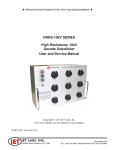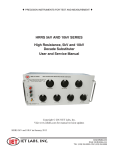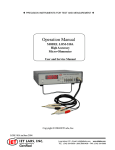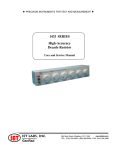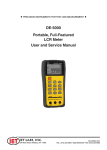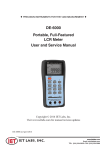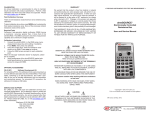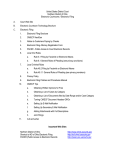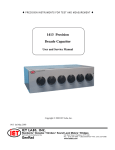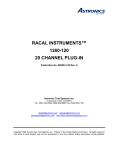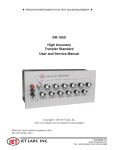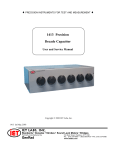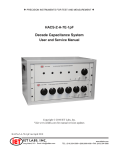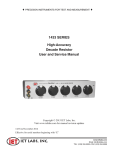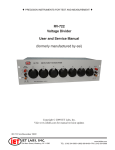Download RTD, Precision Resistance Temperature Detector
Transcript
♦ PRECISION INSTRUMENTS FOR TEST AND MEASUREMENT ♦ RTD Series Precision Resistance Temperature Detector (RTD) Simulator User and Service Manual Copyright © 2014 IET Labs, Inc. Visit www.ietlabs.com for manual revision updates RTD Series-im November 2014 IET LABS, INC. www.ietlabs.com Email: info@ietlabs.com TEL: (516) 334-5959 • FAX: (516) 334-5988 ♦ PRECISION INSTRUMENTS FOR TEST AND MEASUREMENT ♦ IET LABS, INC. www.ietlabs.com Email: info@ietlabs.com TEL: (516) 334-5959 • FAX: (516) 334-5988 WARRANTY We warrant that this product is free from defects in material and workmanship and, when properly used, will perform in accordance with applicable IET specifications. If within one year after original shipment, it is found not to meet this standard, it will be repaired or, at the option of IET, replaced at no charge when returned to IET. Changes in this product not approved by IET or application of voltages or currents greater than those allowed by the specifications shall void this warranty. IET shall not be liable for any indirect, special, or consequential damages, even if notice has been given to the possibility of such damages. THIS WARRANTY IS IN LIEU OF ALL OTHER WARRANTIES, EXPRESSED OR IMPLIED, INCLUDING BUT NOT LIMITED TO, ANY IMPLIED WARRANTY OF MERCHANTABILITY OR FITNESS FOR ANY PARTICULAR PURPOSE. i WARNING OBSERVE ALL SAFETY RULES WHEN WORKING WITH HIGH VOLTAGES OR LINE VOLTAGES. Dangerous voltages may be present inside this instrument. Do not open the case Refer servicing to qualified personnel HIGH VOLTAGES MAY BE PRESENT AT THE TERMINALS OF THIS INSTRUMENT WHENEVER HAZARDOUS VOLTAGES (> 45 V) ARE USED, TAKE ALL MEASURES TO AVOID ACCIDENTAL CONTACT WITH ANY LIVE COMPONENTS. USE MAXIMUM INSULATION AND MINIMIZE THE USE OF BARE CONDUCTORS WHEN USING THIS INSTRUMENT. Use extreme caution when working with bare conductors or bus bars. WHEN WORKING WITH HIGH VOLTAGES, POST WARNING SIGNS AND KEEP UNREQUIRED PERSONNEL SAFELY AWAY. CAUTION DO NOT APPLY ANY VOLTAGES OR CURRENTS TO THE TERMINALS OF THIS INSTRUMENT IN EXCESS OF THE MAXIMUM LIMITS INDICATED ON THE FRONT PANEL OR THE OPERATING GUIDE LABEL. ii Contents Chapter 1 Introduction ..............................................................................1 1.1 Introduction ........................................................................................................... 1 Chapter 2 Specifications ...........................................................................2 Specifications ................................................................................................................ 2 Chapter 3 Installation ................................................................................6 3.1 Initial Inspection ................................................................................................... 6 3.2 Installation............................................................................................................. 6 3.3 Repackaging for Shipment .................................................................................... 6 3.4 Storage .................................................................................................................. 6 Chapter 4 Operation ..................................................................................7 4.1 Initial Inspection and Setup .................................................................................. 7 4.2 Connection ............................................................................................................ 7 4.2.1 4.3 General Considerations ............................................................................... 7 Electrical Considerations ...................................................................................... 7 4.3.1 Thermal emf Considerations....................................................................... 7 4.4 Dial Setting ........................................................................................................... 8 4.5 Power Considerations ........................................................................................... 8 4.6 Environmental Conditions .................................................................................... 8 4.7 Switch Conditioning ............................................................................................. 8 4.8 Meter Shunt Applications ..................................................................................... 9 4.9 Kelvin Bridge Applications................................................................................... 9 Chapter 5 Maintenance..............................................................................11 5.1 Maintainability and Reliability ............................................................................. 11 5.2 Preventive Maintenance ........................................................................................ 11 5.3 Calibration............................................................................................................. 11 5.3.1 Calibration Interval ..................................................................................... 11 5.3.2 General Considerations ............................................................................... 12 5.3.3 Required Equipment ................................................................................... 12 5.3.4 Calibration Procedure ................................................................................. 12 5.4 Adjustments........................................................................................................... 13 5.4.1 Adjustment Considerations ......................................................................... 13 5.4.2 Adjustment/Trimming Procedure ............................................................... 14 5.5 Replaceable Parts List ........................................................................................... 15 iii Figures and Tables Figure 1-1: RTD Series Resistance Substituter ..........................................1 Figure 2-1: Typical Operating Guide Affixed to Unit.....................................4 Figure 4-1: Kelvin Bridge Connections ........................................................9 Table 5-1: Trimming Potentiometers ............................................................16 Figure 5-1: Typical Trimmer Board ...............................................................16 Table 5-2: Replaceable Parts List ................................................................17 Figure 5-2: RTD Series Replaceable Parts .................................................17 iv RTD Series Chapter 1 INTRODUCTION 1.1 Introduction The RTD Series Precision RTD (Resistance Temperature Detector) Simulator provides a very broad-range of absolute resistance values that replace RTD’s,thermocouples. Thermocouples present a resistance that depends on the temperature. The RTD simulator effectively replaces an RTD to test, analyze, and calibrate RTD measuring systems. The RTD Series simulator is a precision resistance source with excellent characteristics of accuracy, stability, temperature coefficient, and power coefficient. All these features serve to make it a laboratory resistance standard, exceeded in performance only by stand-alone standard resistors. The special design of the RTD Series provides absolute accuracy, and requires no zero resistance subtraction from any setting. within the instrument, as well as the solder employed, contain no metals or junctions that contribute to thermal emf problems. The RTD Series is designed to allow very convenient maintenance of calibration over time. The decades for the 0.001 Ω through 0.1 Ω steps are adjusted with convenient potentiometers. Trimming of the higher decades is also possible. With a resolution as low as 1 mΩ and a maximum available resistance of over 1111.11 Ω, the RTD Series may be employed for exacting precision measurement applications requiring high accuracy and stability. They can be used as components of dc and low frequency ac bridges, for calibration, and as well as RTD simulators. Wirewound resistors are used for 1 Ω steps and over. The wirewound resistors exhibit stability of better than 10 ppm/year, improving as they age. The lowresistance resistors are constructed with resistance wire. There is a minimum of copper resistance in series to limit temperature coefficient effects. The RTD Series employs completely enclosed dusttight very low contact resistance switches. They feature solid silver alloy contacts and quadruple-leaf silver alloy wipers which keep switch contact resistance to under 1 mΩ per decade, and more importantly, keep switch contact resistance reproducible, insuring repeatable instrument performance. Figure 1-1: RTD Series Precision RTD Simulator High-quality, low resistance, heavy duty gold-plated tellurium-copper binding posts minimize the thermal emf effects which would artificially reflect a change in dc resistance measurements. All other conductors Introduction 1 RTD Series Chapter 2 SPECIFICATIONS For convenience to the user, the pertinent specifications are given in a typical OPERATING GUIDE, like the one shown in Figure 2.1, affixed to the case of the instrument. SPECIFICATIONS Model RTD-Z-6-.001 RTD-X-6-.001 RTD-Z-6-.01 RTD-X-6-.01 Minimum resistance (Ω) 10.000 10.000 10.00 10.00 Maximum resistance (Ω) 1,111.110 1,111.110 11,111.10 11,111.10 Resolution (mΩ) 1 1 10 10 Number of decades 6 6 6 6 Absolute accuracy (ppm) 50 100 50 100 Tempco max. (ppm/°C) 5 5 5 5 Tempco typical (ppm/°C) 3 3 3 3 Stability (ppm/24hrs) 2 2 2 2 Stability (ppm/year) 10 10 10 10 W cm (in) 43.9(17.3) 43.9(17.3) 43.9(17.3) 43.9(17.3) H cm (in) 8.9(3.5) 8.9(3.5) 8.9(3.5) 8.9(3.5) D cm (in) 10.2(4) 10.2(4) 10.2(4) 10.2(4) Dimensions *At 23°C “true ohm” measurement, 30-70% RH, absolute reading, SI traceable; no zero subtraction required Switch Setting: The 10 Ω switch has two stops at positions 1 and 10. Absolute accuracy, without zero subtraction, is accomplished by having a minimum settable resistance, which includes all contact and wiring resistances. Absolute accuracy applies for every setting. See table above for the minimum settable resistance for any model. Minimum settable resistance is implemented by a mechanical stop in one of the decades. Maximum Power for rated accuracy: 100 mW or 100 mA for 10.000 to 10.999 Ω; 100 mW per step for the highest decade in use for 11 Ω and over. Maximum Current: 200 mA. Breakdown Voltage: 1000 V. 2 Connection to Terminals: 2 terminal devices: use H and L CURRENT terminals 3 terminal devices: use H CURRENT - L CURRENT and G terminals; 4 terminal devices: use all CURRENT and SENSE terminals. (Note: Ground Strap is the only connection between CURRENT and SENSE terminals.) Environmental conditions: Operating temperature: 0ºC to 55ºC. Storage temperature: -40ºC to 70ºC. Humidity: <80% RH. Switch type: Multiple solid silver contacts; dust-tight diallyl-phthalate body. To allow continuous rotation, a blank position is added on all decades except the 10 Ω decade. Specifications RTD Series SPECIFICATIONS CONTINUED Resistor type: Wirewound, hermetically sealed, low-inductance Terminals: Four, 5-way, gold-plated, tellutium-copper binding posts with low thermal emf and low resistance, for four-terminal Kelvin measurements, plus one binding post connected to case for shielding. Options: -RH Rear output is available as an option. Specifications 3 4 SN: G2-1444653 WARNING • Long Island, NY • Email: info@ietlabs.com • Tel: (516) 334-5959 • Fax: (516) 334-5988 www.ietlabs.com Figure 2-2: Typical Operating Guide Affixed to Unit (See label on your specific unit for actual specifications) CAGE CODE: 62015 IET LABS, INC. Observe all safety rules when working with high voltages or line voltages. Connect the (G) terminal to earth ground in order to maintain the case at a safe voltage. Whenever hazardous voltages (>45 V) are used, take all measures to avoid accidental contact with any live components: a) Use maximum insulation and minimize the use of bare conductors. b) Remove power when adjusting switches. c) Post warning signs and keep personnel safely away. MODEL: RTD-Z-6-0.001 RTD lbls/RTD-Z-6-.001/p1/cat09/04-13;55% Switch Setting: The 10 Ω switch has two stops at positions 1 and 10. Use caution so as not to damage the switch. To set values requiring a 0 in the 10 Ω position, follow this example: for a 205 Ω setting, set the dials to 1-10-5-0-0-0. Connection to Terminals: 2 terminal devices: use H and L CURRENT terminals; 3 terminal devices: use H CURRENT - L CURRENT and G terminals; 4 terminal devices: use all CURRENT and SENSE terminals. Switch Break-in: Whenever the unit has been idle, turn each switch 7-10 times both ways before using. This switch "break-in" procedure is standard metrology procedure required for best accuracy to remove any silver oxide film on the contact surfaces, typically <1 mΩ. RTD-Z SERIES RESISTANCE TEMPERATURE DETECTOR (RTD) SIMULATOR Resistor Type: Wirewound, hermetically sealed, low inductance. Accuracy: 50 ppm absolute accuracy without "zero" setting subtraction; true-ohm measurement at CURRENT terminals at 23°C; NIST traceable. Resistance Range: 10.000 Ω to 1,111.110 Ω., with 1 mΩ resolution. Minimum Setting: 10 Ω. Temperature Coefficient: <±5 ppm/°C, 3 ppm/°C typical. Stability: 10 ppm/year. Maximum Power for rated accuracy: 100 mW or 100 mA for 10.000 to 10.999 Ω; 100 mW per step for the highest decade in use for 11 Ω and over. Maximum Current: 200 mA. Breakdown Voltage: 1000 V. RTD Series Specifications RTD Series Chapter 3 Installation 3.1 Initial Inspection 3.3 Repackaging for Shipment IET instruments receive a careful mechanical and electrical inspection before shipment. Upon receipt, verify that the contents are intact and as ordered. The instrument should then be given a visual and operational inspection. If the instrument is to be returned to IET Labs, contact the Service Department at the number or address, shown on the front cover of this manual, to obtain a “Returned Material Authorization” (RMA) number and any special shipping instructions or assistance. Proceed as follows: If any shipping damage is found, contact the carrier and IET Labs. If any operational problems are encountered, contact IET Labs and refer to the warranty at the beginning of this manual. 1. Attach a tag to the instrument identifying the owner and indicate the service or repair to be accomplished. Include the model number, the full serial number of the instrument, the RMA number, and shipping address. 2. Wrap the instrument in heavy paper or plastic. 3. Protect the front panel and any other protrusions with cardboard or foam padding. 4. Place instrument in original container or equally substantial heavy carton. 5. Use packing material around all sides of instrument. 6. Seal with strong tape or bands. 7. Mark shipping container “DELICATE INSTRUMENT,” “FRAGILE,” etc. Save all original packing material for convenience in case shipping of the instrument should become necessary. 3.2 Installation For a rack mounted model, installation in a 19 inch rack may be made using the slots in the rack mounting ears. A mounting location that does not expose the unit to excessive heat is recommended. For bench models there is no required installation. Since this is a high accuracy instrument, it is recommended that a space be provided that would not expose it to mechanical abuse and keep it maintained at laboratory standard temperatures near 23ºC. Installation 3.4 Storage If this instrument is to be stored for any lengthy period of time, it should be sealed in plastic and stored in a dry location. It should not be subjected to temperature extremes beyond the specifications. Extended exposure to such temperatures can result in an irreversible change in resistance, and require recalibration. 5 RTD Series Chapter 4 OPERATION 4.1 Initial Inspection and Setup This instrument was carefully inspected before shipment. It should be in proper electrical and mechanical order upon receipt. An OPERATING GUIDE is attached to the case of the instrument to provide ready reference to specifications. 4.2 Connection Four high performance, low resistance, heavy duty gold-plated tellurium-copper binding posts minimize the thermal emf effects which would artificially reflect a change in dc resistance measurements. All other conductors within the instrument, as well as the solder employed, contain no metals or junctions that contribute to thermal emf problems. 4.2.1 The highest quality low emf components are used in the RTD Series series. In particular, the terminals are made of gold plated tellurium copper, which exhibits low emf and low resistance. There nevertheless may be some minute thermal emf generated at the user’s test leads where they contact the RTD Series binding posts. This will depend on the test lead material. Whenever this is critical, brass and iron materials should be avoided. This emf will be virtually eliminated if a meter with so called “True Ohm” capability is used. Otherwise it may appear as a false component of the dc resistance measurement, and can be the order of milliohms. 4.3 These terminals are labeled CURRENT H, CURRENT L, SENSE H, and SENSE L provide two current and two potential terminals, respectively. In accordance with industry standards, the two SENSE terminals are internally connected to the RTD circuit, and the external shorting links must be connected for 4-terminal measurement, as this is the only connection between CURRENT and SENSE terminals. A fifth metal binding post labeled GND (Ground) is connected to the case and may be used as a guard or shield terminal. When 4-terminal measurements are used, it is best to use banana plugs rather than lugs, because the center conductor of a banana plug is closer to the center of the banana jack. Lugs may result is small differences from the calibrated values - of the order of 5 ppm. 6 Thermal emf Considerations Dial Setting The l0 Ω decade does not go below the “1” position in order to maintain a precise and constant minimum resistance of 10 Ω, so that no subtraction of zero resistance is required. Excise caution so as not force 10 Ω decade dial below 1 position. To set values requiring a 0 in the 10 Ω position, follow this example: for a 205 Ω setting, set the dials to 1-10-5-0-0-0. Whenever the dials are used in positions 0-9, the resulting resistance is read directly. Both the decimal point and the steps are clearly marked on the panel. For additional flexibility and range, each decade provides a “10” position setting. This “10” position on any one decade equals the “1” position on the next higher decade. It adds about 11% to the nominal total decade resistance. Operation RTD Series To determine the resistance obtained when one or more “10” settings are used, simply add “1” to the next higher decade. For example, and a setting of 10-10-l0-10.10-10 Ω becomes: 10 1 0 0 0 0.0 10 1 0 0 0.0 10 1 0 0.0 10 1 0.0 .10 1.0 .01 0.1 ____________________________ TOT Power Considerations To maintain the maximum possible accuracy and precision, power applied to the RTD Series should be kept as low as possible, preferably below 0.1 W. For best protection of the instrument, it is advisable to limit the input power to 0.5 W. This may be implemented with a series resistor or fuse. 4.5 Switch Conditioning The switch wipers employed in this unit are self cleaning. They have solid silver alloy contacts. After being left idle, the wipers and contacts must be conditioned or “broken in” again to remove the film of silver oxide that develops over time. This is standard metrology practice when high accuracy is required. This effect is of the order of less than 1 mΩ, So it may be ignored whenever measurements of that magnitude are not important. 1 1 1 1 1.1 Use caution so as not to damage the switch. To set values requiring a 0 in the 10 Ω position, follow this example: for a 205 Ω setting, set the dials to 1-10-5-0-0-0. 4.4 4.6 To perform this “breaking in,” simply rotate each switch seven to ten times in each direction with the exception of the 10 Ω decade switch which should not be rotated beyond the stops. 4.7 PT 100 Temperature Charts One of the primary applications of the RTD Series is as calibration of temperature equipment that uses PT-100 Thermocouples. Temperature conversion charts are show on the next two pages. Environmental Conditions For optimal accuracy, the decade box should be used in an environment of 23ºC. It should be allowed to stabilize at that temperature for at least four hours after any significant temperature variation. Humidity should be maintained at laboratory conditions of <80% RH. Operation 7 RTD Series 8 Operation RTD Series Operation 9 RTD Series Chapter 5 MAINTENANCE 5.1 Maintainability and Reliability It is possible to maintain Model RTD Series indefinitely. It is reliable due to its closed design and sealed switches and resistors. It is possible to adjust the unit, if necessary, because it has adjustable decades for 1 Ω decades and above and resistance wire for lower decades which can be trimmed. The unit is resistant to electromagnetic interference (EMI) because of its metal enclosure. 5.2 Preventive Maintenance Keep the unit in a clean environment. This will help prevent possible contamination. The Model RTD Series is packaged in a closed case and uses completely sealed switches. This limits the entry of contaminants and dust to the inside of the switches. If it is maintained in a clean or air-conditioned environment, cleaning will seldom be required. Should cleaning be needed: 1. Remove the 4 housing screws from the side of the instrument, and remove the housing. 2. Remove any dust or debris using optical grade dry compressed air or a clean brush. 3. Replace the housing and reattach the 4 housing screws. Wipe the front panel clean using alcohol and a lint-free cloth. 5.3 Calibration The Model RTD Series may be employed as a standalone instrument or as an integral component of a system. If used as part of a system, it should be calibrated as part of the overall system to provide an optimum system calibration. If the RTD Series is employed as a stand alone device, the following should be observed: • Calibration Interval • General Considerations • Required Equipment • Calibration Procedure 5.3.1 Calibration Interval The recommended RTD Series calibration interval is twelve (12) months. If the instrument is used to transfer resistance values only, recalibration is not required, assuming that there has been no drastic change in the deviations of any individual resistors. The front panel should be periodically cleaned to eliminate any leakage paths from near or around the binding posts. To clean the front panel: 10 Maintenance RTD Series 5.3.2 Before starting the calibration procedure, you need to consider the following: • Calibration environment should be 23°C and less than 50% relative humidity. • Test instruments should be sufficiently more accurate than the RTD Series unit, and/or the uncertainty of the measurement instrumentation has to be considered in the calibration Test Uncertainty Ratio (TUR). • The testing equipment and the RTD Series unit should stabilize at laboratory conditions for at least 24 hours. • Kelvin type 4-wire test leads should be used to obtain accurate low resistance measurements. • Steps should be taken to minimize thermal emf effects, such as using a meter with “True Ohm” capacity. • Accepted metrology practices should be followed. 5.3.3 Required Equipment Many combinations of standards, transfer standards, meters, and bridges may be used to calibrate this instrument. The following are some possible choices: • • • General Considerations • 5.3.4 IET/ESI model 242, 242A, 242C, or 242D A high-precision, high-stability digital multimeter (e.g. Fluke 8508A) along with a set of resistance standards for ratio mode. Calibration Procedure To calibrate the RTD Series unit, proceed as follows: 1. Set up the calibration equipment in the resistance measurement mode and exercise the switches 10 times in each direction. 2. Allow the switches to cool for 15 minutes. 3. Confirm the minimum resistance of the unit. Allow a confidence band for the uncertainty of the measuring instrument and setup. 4. Determine the allowable upper and lower limits for each resistance setting of each decade based on the specified accuracy and the confidence band for the RTD being tested. 5. Confirm that the resistances fall within these limits. 6. If any resistances fall outside these limits, the associated switch assembly may require adjustment or replacement. Resistance Standards or Transfer Standards for 1 Ω, 10 Ω, 100 Ω, 1 kΩ, 10 kΩ, 100 kΩ, 1 MΩ, and 10 MΩ per step, calibrated to ±10 ppm. IET options include the following models: • HATS-LR • HATS-Y • SRL Series The 1 Ω, and 10 Ω transfer standards are optional, and are only used to take advantage, if desired, of the adjustability of these two decades Precision resistance measurement bridge or multimeter, with a transfer accuracy of ±l ppm. Options include: • Guildline Model 9975 • Measurements International Model 6000A Maintenance 11 RTD Series 5.4 Adjustments If one or more resistances fall outside the limits, the associated resistor should be adjusted. There is a trimming network provided for each resistance in these ranges. These may be accessed by removing the housing and accessing the particular decade PC board. Adjust the resistors from lowest to highest. The order of decades does not matter. Whereas it is possible to adjust any one resistance step, note that the nth step of a decade is the sum of resistances 1 through n, so that errors are cumulative. It is therefore recommended that whenever any resistance of a particular decade is adjusted, that all the resistances of that decade be tested and adjusted as required. To adjust any of the resistances, the following should be observed: • Adjustment considerations • Adjustment procedure 5.4.1 Adjustment Considerations Before adjusting or trimming any resistances, observe the following: CAUTION The RTD Series front panel GND binding post should be connected to the test instrument’s ground point. The equipment measuring the unit should conform to the guidelines provided in Section 5.3. 12 5.4.2 Adjustment/Trimming Procedure To trim or adjust any resistances, proceed as follows: 1. Stabilize RTD Series at laboratory temperature of 23 °C for at least 8 hours. 2. Remove the 4 housing screws from the sides of the instrument and remove the housing. 3. Using the binding posts in the 4-terminal connection, connect RTD Series to a resistance meter. 4. Rotate all knobs approximately 10 times and be careful not to rotate the minimum setting decade beyond the stops. Breaking in the switches helps eliminate any residual contact corrosion resistance. 5. Set all dials to zero, except the 10 ohm decade which has a minimum stop at position 1. 6. Measure the 10 Ω setting. It should be a 10 Ω ± 2 ppm; if an adjustment is needed, proceed as follows: 7. Turn the potentiometer T0 on the lowest decade board either 0.001 Ω or 0.01 Ω board fully clockwise and record the reading. 8. Turn the potentiometer T0 on the lowest decade board either 0.001 Ω or 0.01 Ω fully counter-clockwise and record the reading. 9. Set the potentiometer to obtain the midpoint resistance reading between maximum and minimum. 10. Repeat the same process for the 0.01 ohms and 0.1 ohms decades as applicable. 11. Setting these T0 potentiometers to their midpoints will bring the fixed 10 ohms very close to its nominal. 12. Re-measure 10 Ω minimum. The number should be very close to its nominal. If any adjustments are necessary, Locate a piece of manganin resistance wire l T-11, on the lowest decade 0.001 Ω or 0.01 Ω board. 13. Trim the wire as follows. If the 10 Ω resistance is high, reduce it by adding a small bit of solder to an exposed portion of the wire. If the 10 Ω resistance is low, gently file the wire in one spot. Make these steps carefully and slowly, allowing the wire to cool down and re-measuring. Maintenance RTD Series 14. Once the 10 Ω adjustment is completed, follow the Table 5-1 below for each decade less than 0.1 Ω. 15. Use Fig 5-1 to locate the potentiometers on the decades, 0.001 Ω, 0.01 Ω, and 0.1 Ω 16. Replace the housing and reinstall the 4 housing screws. Setting on the RTD-Z 1 2 3 4 5 6 7 8 9 10 Potentiometer on RTD-Z PCBoard T1 T2 T3 T4 T5 T6 T7 T8 T9 T10 Table 5-1: Trimming Potentiometers Trim Potentiometers Figure 5-1: Typical Trimmer Board Maintenance 13 RTD Series 5.5 Replaceable Parts List Model Ref 1 2 3 4 Not Shown Not Shown Not Shown Not Shown Not Shown Not Shown Not Shown IET Pt No Description BP-1000-RD Binding Post, Red BP-1000-BK Binding Post, Black BP-1000-GN Binding Post, Green RTD Series-4300-KNB Knob Assembly RTD Series-3100 RTD-4000-.001 RTD-4000-0.01 Foot 1 mΩ/step Decade Switch Assembly 10 mΩ/step Decade Switch Assembly RTD-4000-LX-0.1 100 mΩ/step Decade Switch Assembly RTD-4000-1 1 Ω/step Decade Switch Assembly RTD-4000-10 10 Ω/step Decade Switch Assembly RTD-4000-100 100 Ω/step Decade Switch Assembly Table 5-2: Replaceable Parts List 1 4 2 3 14 Figure 5-2: RTD Series Replaceable Parts Maintenance





















